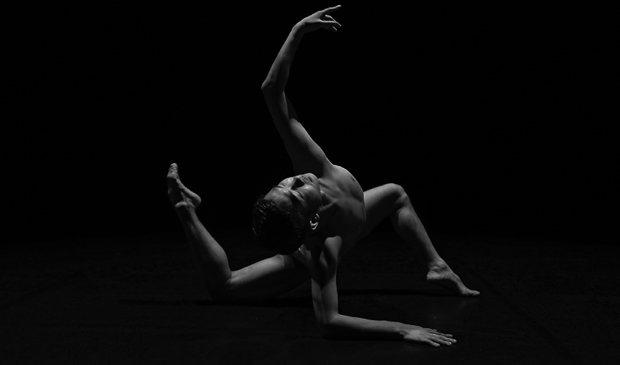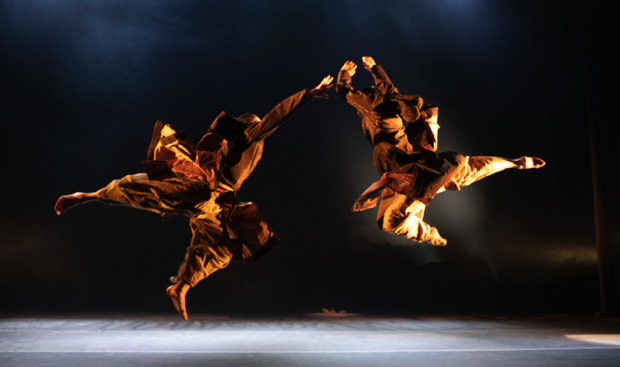Aakash Odedra Company, Samsara review ★★★★★
Aakash Odedra Company’s Samsara showing at Sadler’s Wells is an epic of cultural cross-fertilisation performed by two mesmerising dancers
Aakash Odedra Company, Samsara. Dancers: Aakash Odedra, Hu Shenyuan. Photo: Nirvair Singh Rai
Heavy symbolism pervades the entirety of Samsara, a highly sophisticated production which uses as its starting point Wu Cheng'en’s 16th-century Chinese novel Journey to the West. One of the great classical novels of Chinese literature, it tells the story of the legendary pilgrimage to India by the monk Xuanzang, who returned to China with the central tracts of Buddhist philosophy.
Samsara is thus built as a journey both literal, referencing Xuanzang’s pilgrimage, and metaphorical, pointing towards a personal journey of self-discovery. Both journeys are crystallised in the encounters between the two cultures – Chinese and Indian – in totally entrancing duets by two extraordinary dancers: Hu Shenyuan and Aakash Odedra.
They meet on a desert landscape, peopled by designer Tina Tzoka's spectral human statues, duskily and atmospherically lit by Yaron Abulafia. We first see Hu Shenyuan within a circle of scant light, divested of all props. He dances, his astonishing expressive body creating shapes of breathtaking beauty.
You’d be hard put to find a more graceful, yet strong dancer.

Samsara by Aakash Odedra Company at Peepul Centre. Dancer Hu Shenyuan. Photo: Nirvair Singh Rai
Wrapped in a hooded cape, he then sets off on his pilgrimage, lines of spotlights above the stage leading him on his slow, tentative way.
When he meets Odedra, himself a compelling dancer trained in the classical Indian dance form of Kathak, at first the two cultures clash, and fighting duets bring thrilling energy to the performance, the two men circling each other, each seeking, and failing, to exert supremacy over the other.

Samsara by Aakash Odedra Company. Dancers: Hu Sheyuan & Aakash Odedra. Photo: Nirvair Singh Rai
Nicki Wells's specially commissioned score, which includes Mongolian throat singing and Chinese percussion, is played and sung live, the musicians just visible at the back of the stage. A soaring ethereal female voice accompanies Hu on his pilgrimage and gives way to vigorous, pounding drumming when the two men meet.
Gradually, though, the two men are enticed by each other’s culture and seek to understand and embody their differences. At this point the choreography starts knitting the two bodies together: Odedra sits cross-legged on the ground, while behind Hu wraps his body around him, two sets of hands fluttering in front.
Plunged in orange-tinted light, driven by an unusually eloquent score, the two dancers find common ground, and the final section sees them dragging sand over the stage, slowly pouring it on each other, even while thin showers of sand rain down from above.
The Sanskrit word 'samsara' means birth, death and rebirth, and the skilful use of sand denotes the cycle of time in its infinity, Hu’s personal journey continuing even as his physical pilgrimage draws to a close.
Samsara is a work of rare beauty, its symbolism accessible yet never loud, Lou Cope’s dramaturgy bringing a commendable light touch to story-telling. And in dancers and joint choreographers Hu Shenyuan and Aakash Odedra, it has interpreters of the highest calibre.
Samsara is thus built as a journey both literal, referencing Xuanzang’s pilgrimage, and metaphorical, pointing towards a personal journey of self-discovery. Both journeys are crystallised in the encounters between the two cultures – Chinese and Indian – in totally entrancing duets by two extraordinary dancers: Hu Shenyuan and Aakash Odedra.
They meet on a desert landscape, peopled by designer Tina Tzoka's spectral human statues, duskily and atmospherically lit by Yaron Abulafia. We first see Hu Shenyuan within a circle of scant light, divested of all props. He dances, his astonishing expressive body creating shapes of breathtaking beauty.
You’d be hard put to find a more graceful, yet strong dancer.

Samsara by Aakash Odedra Company at Peepul Centre. Dancer Hu Shenyuan. Photo: Nirvair Singh Rai
Wrapped in a hooded cape, he then sets off on his pilgrimage, lines of spotlights above the stage leading him on his slow, tentative way.
When he meets Odedra, himself a compelling dancer trained in the classical Indian dance form of Kathak, at first the two cultures clash, and fighting duets bring thrilling energy to the performance, the two men circling each other, each seeking, and failing, to exert supremacy over the other.

Samsara by Aakash Odedra Company. Dancers: Hu Sheyuan & Aakash Odedra. Photo: Nirvair Singh Rai
Nicki Wells's specially commissioned score, which includes Mongolian throat singing and Chinese percussion, is played and sung live, the musicians just visible at the back of the stage. A soaring ethereal female voice accompanies Hu on his pilgrimage and gives way to vigorous, pounding drumming when the two men meet.
Gradually, though, the two men are enticed by each other’s culture and seek to understand and embody their differences. At this point the choreography starts knitting the two bodies together: Odedra sits cross-legged on the ground, while behind Hu wraps his body around him, two sets of hands fluttering in front.
Plunged in orange-tinted light, driven by an unusually eloquent score, the two dancers find common ground, and the final section sees them dragging sand over the stage, slowly pouring it on each other, even while thin showers of sand rain down from above.
The Sanskrit word 'samsara' means birth, death and rebirth, and the skilful use of sand denotes the cycle of time in its infinity, Hu’s personal journey continuing even as his physical pilgrimage draws to a close.
Samsara is a work of rare beauty, its symbolism accessible yet never loud, Lou Cope’s dramaturgy bringing a commendable light touch to story-telling. And in dancers and joint choreographers Hu Shenyuan and Aakash Odedra, it has interpreters of the highest calibre.
TRY CULTURE WHISPER
Receive free tickets & insider tips to unlock the best of London — direct to your inbox
| What | Aakash Odedra Company, Samsara review |
| Where | Sadler's Wells, Rosebery Avenue, London, EC1R 4TN | MAP |
| Nearest tube | Angel (underground) |
| When |
17 Oct 22 – 18 Oct 22, 19:30 Dur.: 1 hour no interval |
| Price | £20-£25 (+booking fee) |
| Website | Click here to book |